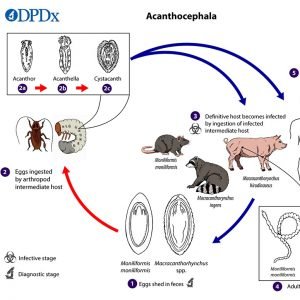
So, grab a cup of coffee, and let’s dive into the life cycle of the Acanthocephala together. It’s a bit like following a character in a novel—only this character happens to be a parasitic worm with some serious survival skills. By breaking down their journey, we can appreciate just how these creatures operate and why their life cycle matters in the broader scheme of ecology.
What Are Acanthocephala?
Acanthocephala, or thorny-headed worms, are a phylum of parasitic worms that have a unique body structure. What sets them apart is their spiny proboscis, which they use to cling to the intestines of their hosts. This might sound a bit gruesome, but it plays a crucial role in their survival. These worms typically inhabit the intestines of vertebrate hosts, including fish, birds, and mammals, and their life cycle is interlinked with that of their hosts.
The Acanthocephala are fascinating not just because of their anatomy but also due to their life cycle, which involves multiple stages and hosts. This adaptability allows them to thrive in various environments, which is a key to their success as parasites. Now, let’s explore how they navigate through their life cycle.
Stage 1: Egg Stage
The life cycle of the Acanthocephala begins with their eggs. These tiny, thorny eggs are released into the environment through the feces of their host. This might take place in water or soil, where they can remain viable for extended periods. Imagine them like tiny time capsules, waiting for the right conditions to hatch.
When the right intermediate host, usually an invertebrate like an insect or a crustacean, consumes these eggs, they hatch into larvae. This is where the journey kicks into high gear. The larvae will begin to develop inside the intermediate host, where they’ll undergo significant changes, preparing for the next phase of their life cycle.
Stage 2: Larval Stage
Once the eggs hatch inside the intermediate host, Acanthocephala larvae start their development into a stage known as the cystacanth. This stage is crucial because the larvae change significantly during this time. They grow spines and develop their characteristic proboscis while inside the host’s body.
You might wonder what happens to these larvae inside the intermediate host. Well, as they mature, they begin to affect the behavior of their host. Some studies suggest that these larvae can manipulate their host’s behavior, making them more likely to be eaten by a definitive host, usually a larger vertebrate. It’s almost like they’re pulling strings for their own benefit—a vivid example of how survival instincts can shape behavior in nature.
Stage 3: Definitive Host Stage
The journey of the Acanthocephala takes a significant turn once they manage to enter their definitive host. This host is typically a vertebrate, like a fish, bird, or mammal. When the intermediate host is consumed by the definitive host, the cystacanths are released and attach themselves to the intestines. Here’s where their real lifestyle begins.
In this stage, the Acanthocephala can grow to their full size, which can range from a few millimeters to several centimeters. They reproduce by shedding more eggs into the environment, and the cycle starts all over again. It’s a classic case of nature’s way of ensuring the species survives and thrives, even if it means using others in the process.
Behavioral Adaptations
You might be curious about how these worms manage to survive and thrive in such varied environments. One of their most remarkable behavioral adaptations is the ability to manipulate their host’s behavior. By increasing the likelihood of the host being eaten by a definitive host, they ensure the continuation of their life cycle.
Aside from this manipulation, Acanthocephala also exhibit specific feeding behaviors. They attach themselves firmly to the intestinal walls, using their spiny proboscis. This can cause damage to the host’s intestines, leading to health issues. The relationship between Acanthocephala and their hosts is a fine balance of survival: the worms thrive, while their hosts suffer from the consequences.
Ecological Role of Acanthocephala
The role of Acanthocephala in ecosystems is complex and significant. They’re not just passive participants; they actively influence the populations of their hosts. By affecting the health of fish, birds, and mammals, these worms can play a role in regulating populations within their ecosystems.
For instance, an outbreak of Acanthocephala in a fish population can lead to decreased fish health, which could impact local fishing industries or the whole food chain. Here’s the thing: while they’re often seen as harmful, they can also serve as indicators of ecological health. A diverse population of Acanthocephala might suggest a stable ecosystem, while their sudden decline could indicate something amiss.
The life cycle of the Acanthocephala is a fascinating example of adaptation and survival in the animal kingdom. From their egg stage to their transformative journey through intermediate and definitive hosts, these thorny-headed worms navigate a complex life cycle that’s as captivating as it is crucial for their survival.
Understanding these worms can shed light on the intricate relationships in ecosystems and the roles various organisms play. So, the next time you hear about parasites, consider the Acanthocephala and their remarkable journey through life. They may not be the most glamorous creatures, but their story is a testament to nature’s ingenuity and resilience.
